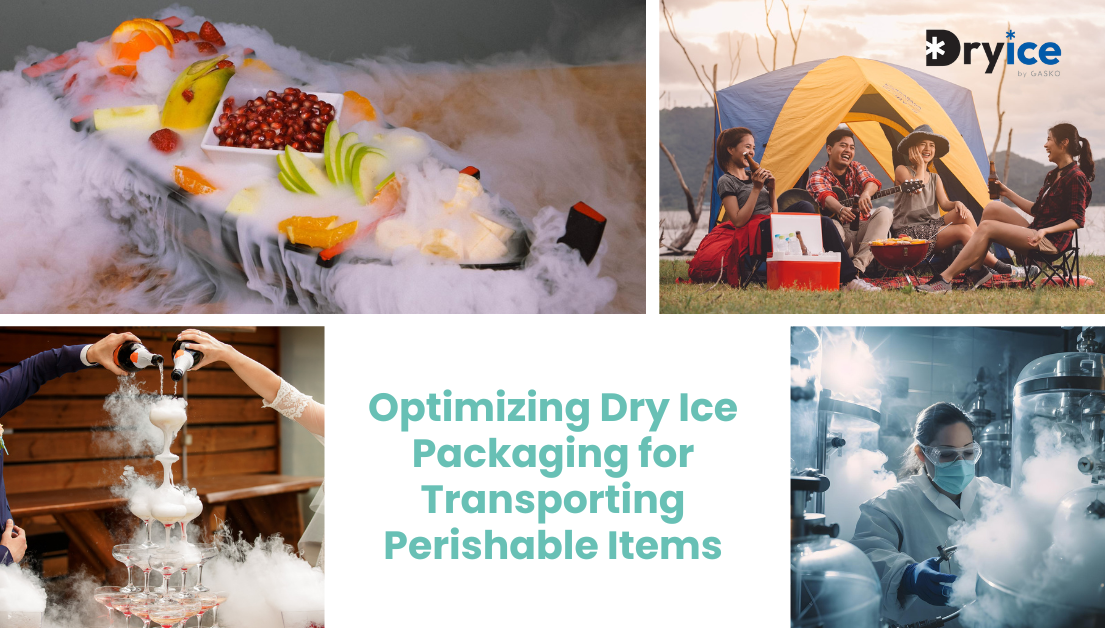There are many reasons for transporting food and drinks from one location to another. These include delivering frozen food directly to customers, bringing cooking materials to a camping site for a BBQ outing, exporting agricultural products via airfreight, transporting pet food, and allowing travelers to check in perishable souvenirs at the airport. Additionally, medical research and pharmaceutical testing specimens often require cold storage during transportation.
Transporting perishable food, drinks, and medical science and laboratory items is a critical aspect of the supply chain that requires meticulous planning and execution. To ensure the freshness and safety of these items, especially during long-distance transportation, dry ice has emerged as a reliable and effective solution. Today, let’s explore the various applications of dry ice in transporting perishable goods, highlighting its importance in maintaining the integrity of food, drinks, and beyond.
Dry Ice for Drinks
Dry ice is commonly used to keep beverages cold during transportation. It sublimates directly from solid to gas without leaving any residue, making it an ideal cooling agent. For transporting drinks, particularly in large quantities, dry ice ensures that they remain at the desired temperature without the risk of melting ice diluting the products. This is particularly beneficial for events, catering services, and large shipments of beverages.
Dry Ice for Preservation
Preserving the quality and freshness of perishable food items during transit is crucial. Dry ice is a highly effective preservative due to its extremely low temperature (-78.5°C or -109.3°F). When used in transportation, it helps maintain the cold chain, preventing the growth of bacteria and spoilage. This preservation method is essential for ensuring that food reaches its destination in the best possible condition.
Dry Ice for Meat Storage
Transporting meat products requires strict temperature control to prevent spoilage and maintain quality. Dry ice is perfect for this purpose as it can keep meat at the required low temperatures throughout the journey. Whether it’s beef, poultry, or seafood, dry ice helps in maintaining the freshness and safety of these products, ensuring they remain suitable for consumption upon arrival.

Dry Ice for Agricultural Products and Fruit Storage
Fruits are delicate and highly perishable, requiring careful handling and appropriate temperature conditions during transportation. Dry ice provides an effective way to keep fruits fresh and prevent them from ripening too quickly. By slowing down the ripening process, dry ice helps extend the shelf life of fruits, allowing them to reach their destination in prime condition. For example, the local durians from Malaysia can be transported to international markets while maintaining their quality.
Dry Ice for Ice Cream
Ice cream is one of the most temperature-sensitive products, requiring constant freezing conditions to maintain its texture and taste. Dry ice is an excellent solution for transporting ice cream as it provides consistent and extremely low temperatures. This ensures that the ice cream remains solid and does not melt during transit, delivering a perfect product to consumers.
Dry Ice for Medical Science and Laboratory Use
Dry ice also plays a crucial role in the medical and laboratory fields, where maintaining specific temperature conditions is essential. It is used for shipping biological samples, vaccines, pharmaceuticals, and other temperature-sensitive materials. Dry ice ensures that these items remain at the necessary low temperatures, preserving their integrity and effectiveness. Additionally, it is used in laboratories for various purposes, including cryogenic grinding, flash freezing, and cold storage of specimens.

Additional Benefits of Using Dry Ice
1. Non-Toxic and Safe
Dry ice is a non-toxic substance, making it safe to use in food transportation. It does not leave any residue or chemical contaminants, ensuring that the food remains pure and uncontaminated.
2. Cost-Effective
Compared to other cooling methods, dry ice is relatively cost-effective. It lasts longer than traditional wet ice and reduces the need for bulky refrigeration equipment.
3. Environmentally Friendly
As dry ice sublimates into carbon dioxide gas, it does not contribute to water waste or pollution. Its use in transportation aligns with eco-friendly practices, reducing the environmental impact of shipping perishable goods.
In conclusion, dry ice plays a crucial role in the transportation of time-sensitive perishable food, drinks, and medical science and laboratory items. Its ability to maintain low temperatures, preserve freshness, and ensure safety makes it an indispensable tool in the supply chain. By leveraging the benefits of dry ice, businesses can ensure their products reach consumers in the best possible condition, enhancing satisfaction and trust.
Try our Dry Ice Calculator to determine the optimal amount needed for your next cold storage when transporting perishable items: https://gasko.my/calculators/
For Dry Ice sourcing, click here to find out more.

 Our Story
Our Story  Our Leader
Our Leader  Our Culture
Our Culture  Our Value
Our Value  Accreditation
Accreditation  Sustainability
Sustainability  Gasko Dry Ice Overview
Gasko Dry Ice Overview  Unique Celebrations with Dry Ice and Helium Gas
Unique Celebrations with Dry Ice and Helium Gas  Food Presentation
Food Presentation  ASCO Dry Ice Blasting
ASCO Dry Ice Blasting  Industry Solutions
Industry Solutions  Shipping and Transportation
Shipping and Transportation  Laboratory and Scientific Experiment
Laboratory and Scientific Experiment  Camping and Outing
Camping and Outing 

